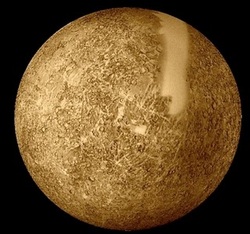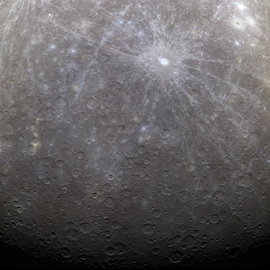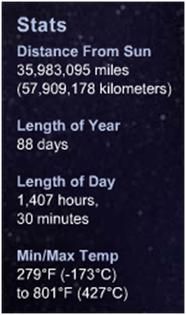Our Solar System
Planet Mercury

Being the planet closest to the Sun, Mercury (the Messenger of the gods) guards its secrets very carefully. With a mean heliocentric distance of just 0.3871 AU (about 57.8million km) and a orbit time of just under 88 days, it is quite tricky to observe from Earth and never appears more than 27° from the Sun (less than the angle made by the hands of a watch at 1 o'clock).
Mercury's elliptical orbit takes the small planet as close as 29 million miles (47 million kilometers) and as far as 43 million miles (70 million kilometers) from the sun. If one could stand on the scorching surface of Mercury when it is at its closest point to the sun, the sun would appear almost three times as large as it does when viewed from Earth.
Temperatures on Mercury's surface can reach 800 degrees Fahrenheit (430 degrees Celsius). Because the planet has no atmosphere to retain that heat, nighttime temperatures on the surface can drop to -280 degrees Fahrenheit (-170 degrees Celsius).
Because Mercury is so close to the sun, it is hard to directly observe from Earth except during twilight. Mercury makes an appearance indirectly, however, 13 times each century. Earth observers can watch Mercury pass across the face of the sun, an event called a transit. These rare transits fall within several days of May 8 and November 10.
Scientists used to think that the same side of Mercury always faces the sun, but in 1965 astronomers discovered that the planet rotates three times during every two orbits. Mercury speeds around the sun every 88 days, traveling through space at nearly 31 miles (50 kilometers) per second faster than any other planet. The length of one Mercury day (sidereal rotation) is equal to 58.646 Earth days.
Mercury's elliptical orbit takes the small planet as close as 29 million miles (47 million kilometers) and as far as 43 million miles (70 million kilometers) from the sun. If one could stand on the scorching surface of Mercury when it is at its closest point to the sun, the sun would appear almost three times as large as it does when viewed from Earth.
Temperatures on Mercury's surface can reach 800 degrees Fahrenheit (430 degrees Celsius). Because the planet has no atmosphere to retain that heat, nighttime temperatures on the surface can drop to -280 degrees Fahrenheit (-170 degrees Celsius).
Because Mercury is so close to the sun, it is hard to directly observe from Earth except during twilight. Mercury makes an appearance indirectly, however, 13 times each century. Earth observers can watch Mercury pass across the face of the sun, an event called a transit. These rare transits fall within several days of May 8 and November 10.
Scientists used to think that the same side of Mercury always faces the sun, but in 1965 astronomers discovered that the planet rotates three times during every two orbits. Mercury speeds around the sun every 88 days, traveling through space at nearly 31 miles (50 kilometers) per second faster than any other planet. The length of one Mercury day (sidereal rotation) is equal to 58.646 Earth days.
Mercury Surface

Mercury's surface resembles that of Earth's moon, scarred by many impact craters resulting from collisions with meteoroids and comets. While there are areas of smooth terrain, there are also lobe-shaped scarps or cliffs, some hundreds of miles long and soaring up to a mile (1.6 kilometers) high, formed by early contraction of the crust. The Caloris Basin, one of the largest features on Mercury, is about 800 miles (1,300 kilometers) in diameter. It was the result of an asteroid impact on the planet's surface early in the solar system's history. Over the next half-billion years, Mercury shrank in radius about 0.6 to 1.2 miles (1 to 2 kilometers) as the planet cooled after its formation. The outer crust contracted and grew strong enough to prevent magma from reaching the surface, ending the period of geologic activity.
Mercury is the second smallest planet in the solar system, larger only than previously measured planets, such as Pluto. Mercury is the second densest planet after Earth, with a large iron core having a radius of 1,100 to 1,200 miles (1,800 to 1,900 kilometers), about 75 percent of the planet's radius. Mercury's outer shell, comparable to Earth's outer shell (called the mantle), is only 300 to 400 miles (500 to 600 kilometers) thick. Mercury's magnetic field is thought to be a miniature version of Earth's, but scientists are uncertain of the strength of the field.
Mercury is the second smallest planet in the solar system, larger only than previously measured planets, such as Pluto. Mercury is the second densest planet after Earth, with a large iron core having a radius of 1,100 to 1,200 miles (1,800 to 1,900 kilometers), about 75 percent of the planet's radius. Mercury's outer shell, comparable to Earth's outer shell (called the mantle), is only 300 to 400 miles (500 to 600 kilometers) thick. Mercury's magnetic field is thought to be a miniature version of Earth's, but scientists are uncertain of the strength of the field.

